| We describe a young squirrel as one who,
in the wild, would still be dependent on its mother in some way; usually
less than 12 weeks old.
It is easy to pick up and hold youngsters less than about
12 weeks old. They will present no threat at all! They tend to become
a little more mobile after this age, but it would be very rare for a youngster
to hurt you.
Important note:
Do not snatch or grab at a squirrel as squeezing
too hard can cause internal injury.
Do not attempt to catch a squirrel by the tail.
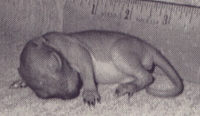 |
0-2 WEEKS
Called a ‘pinkie’ due to having no fur.
About the size of a small thumb.
Umbilical cord may still be present.
Eyes closed. |
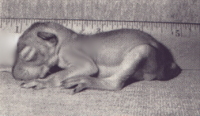 |
2-3 WEEKS
Develops dark pigmentation down back.
Whiskers start to grow. |
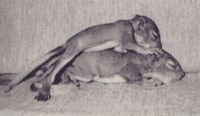 |
3-4 WEEKS
Some fur appears.
Lower incisors start to develop.
Average weight 90g. |
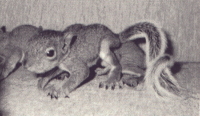 |
5-6 WEEKS
Fur all over including fine tail hair.
Upper incisors start to develop.
Eyes may begin to open. |
| Gradually, the tail will become bushier. The squirrel
may start to venture out of its nest and need space to play. Claws
and teeth will have developed. At around about 8 weeks of age squirrels
will start to take an interest in solid foods and water. |
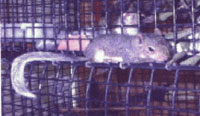 |
10-12 WEEKS
Well on the way to full size and being independent.
Pretty active! |
Squirrels tend to reach full size
within a year. It is virtually impossible to distinguish between
males and females without close inspection.
In captivity squirrels often reach 10 years of
age or more, but life in the wild is somewhat tougher, so life expectancy
is therefore quite a bit lower. |
|

